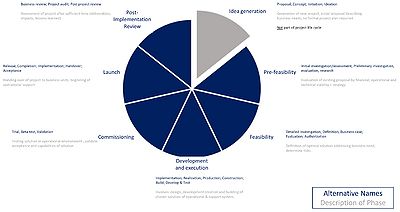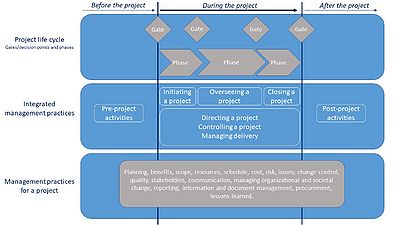Post-Implementation Review (PIR)
(→PIR as part of the project life cycle) |
m (→PIR as part of the project life cycle) |
||
| Line 13: | Line 13: | ||
==PIR as part of the project life cycle== | ==PIR as part of the project life cycle== | ||
| − | + | [[File:ISO215022020.jpg|400px|thumb|right|Figure 1 Relationship between project life cycle, integrated project management practices and management practices for a project according to ISO21502:2020. Created by Jakob Kehler]] | |
According to ISO 21502:2020, a project life cycle is a “defined set of phases from the start to the end of a project […] [where] the number and names of a project´s phases upon the type of project being undertaken”. To define the different phases, following categories need to be considered when defining the project life cycle:<ref name="ISO21502"></ref> | According to ISO 21502:2020, a project life cycle is a “defined set of phases from the start to the end of a project […] [where] the number and names of a project´s phases upon the type of project being undertaken”. To define the different phases, following categories need to be considered when defining the project life cycle:<ref name="ISO21502"></ref> | ||
| Line 21: | Line 21: | ||
* Nature of characteristics of the project | * Nature of characteristics of the project | ||
* Other organizational & environmental factors | * Other organizational & environmental factors | ||
| − | [[File: | + | |
| + | [[File:SustainableProjectLifeCycle.jpg|400px|thumb|right|Figure 1 Proposed project life cycle phases for sustainable project life cycle management in the manufacturing according to <ref name="Sustainable Project Life Cycle Management: the need to integrate life cycles in the manufacturing sector"></ref>. Created by Jakob Kehler]] | ||
Revision as of 15:48, 20 February 2022
Author: Jakob Kehler, February 2022
The Post-Implementation Review (PIR) (also known as Business Review, Project Audit or Post-Project Review) is a methodology that can be applied to evaluate the success of a project after it has been undertaken based on 1. the key deliverables of the project, 2. the process itself going through all life cycles of a project and 3. the delivery of the business case. [1]
In ISO 21502, the project life cycle is defined as a "defined set of phases from the start to the end of the project". This includes the initiation of the project up to all activities including the closure of the project. Pre- and post-project activities are not included in the project life cycle. [2] Nevertheless, a project itself may have only minimal impact on the economy, environment and society in contrast to its deliverables. Taking this into account, a PIR is a useful methodology to review projects that are characterized by its temporary nature "within a broader framework of organizational objectives and given contexts and environments". [1].
This article will guide project managers on how to perform high quality PIRs by giving examples of several different industries, then elaborating its benefits and limitations.
The importance of a PIR is theoretically highly acknowledged whereas due to several reasons it is often not used in a practical setting. This is not only due to a missing general framework. In today´s fast changing world, a PIR sets the foundation for knowledge management as is successes and failures can be shared to guarantee an increasing success rate in upcoming projects.[1].
Contents |
PIR as part of the project life cycle
According to ISO 21502:2020, a project life cycle is a “defined set of phases from the start to the end of a project […] [where] the number and names of a project´s phases upon the type of project being undertaken”. To define the different phases, following categories need to be considered when defining the project life cycle:[2]
- Risks
- Control factors
- Organizational & project governance
- Nature of characteristics of the project
- Other organizational & environmental factors

Besides their temporary nature, projects are distinguished by their uniqueness. The output of a project is a service or product which differs from all the other products or services that have yet been created. [1].
ISO 21502:2020 shows that the project life cycle itself must be defined by the project managers with each phases having a clear start and end date. In contrast to the project lifecycle, management practices for the project cover activities taken before, during and after the project as seen in Figure 1. [2]
“`Completing a project´ is not the same thing as ending the project management process.” [4]
The success of a project can be traditionally defined by the three dimensions of the Iron triangle: Cost, Quality and Time. However, due to the temporary characteristic of the project, the deliverable must not be of a temporary nature either as the project itself may only be a small part of the deliverable itself. [1]. That is why the PIR goes beyond these three factors. Elements and activities can be identified that play an important role for the success of a project. [5]
For example, a life cycle could consist of the 6 phases with clear start and end phases. The initiation phase takes place before the pre-feasibility phase and is not part of the project life cycle itself. [3]
How a PIR can contribute to sustainable Project Management
1. General definition of a Project (refer to Magic Triangle & Project Life Cycle) 2. Status Quo (literature review)
Guidance on how to create high quality PIR
1. General idea of a framework 2. Examples across different industries with its different focus points (Finance, Service, Construction)
Limitations & Benefits
Explaining its limitations and benefits (refer to "Types of Uncertainty" Matrix)
References
- ↑ 1.0 1.1 1.2 1.3 1.4 Jewels, Tony; Baker, Jason; Underwood, Alan, Post Implementation Reviews - A means of Applying Knowledge: Lessons from a failed project, 14th Australasian Conference on Information Systems (Perth, 2003)
- ↑ 2.0 2.1 2.2 ISO 21502
- ↑ 3.0 3.1 C. Labuschagne and A. C. Brent, "Sustainable Project Life Cycle Management: the need to integrate life cycles in the manufacturing sector" International Journal of Project Management, vol. 23, pp. 159-168, 2005
- ↑ mindtools, "Post-Implementation Reviews - Making Sure That What You Delivered Actually Works," mindtools, 2022. [Online]. Available: https://www.mindtools.com/pages/article/newPPM_74.html
- ↑ C.-T. Dogaru and A.-M. Dogaru, "The Importance of Project Post-Implementation Reviews," International Journal of Economics and Management Engineering, vol. 9, no. 11, pp. 4031-4036, 2015
